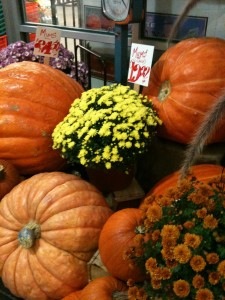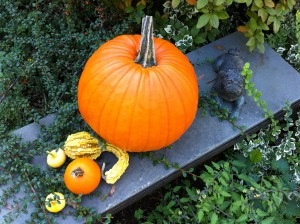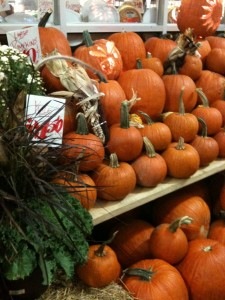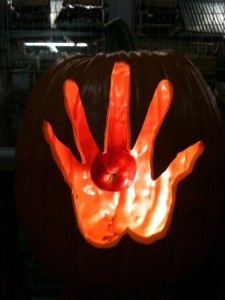
Mine has and I finally found out why.
Although lots of us buy pumpkins to cook the pumpkin flesh or toast the seeds (pumpkins have more beta carotene per serving than any other fruit or vegetable), many of us never buy pumpkins except to use as jack-o’-lanterns or for decoration.
Many commercially available “Halloween” pumpkins are specifically grown to be oversized, thin-walled, with a huge seed pocket and a relatively small proportion of flesh.
Smaller sugar pumpkins have more fleshy pumpkin meat for cooking and often have better flavor and texture.
Will Your Jack-o’-Lantern Be Spooky, Happy, Or Creepy?
Pumpkins come in many sizes, shapes, and colors so pick whatever yanks your chain. Sometimes that’s not so easy because if you go with your family everyone often has his or her own vision of what’s appropriately spooky or decorative.
I bought a really great white pumpkin this year — along with an oddly shaped orange one. I’m not going to carve the white one. It’s sitting on a rock peering out through some sword-leaved yuccas. Looks great – some members of my family think it’s weird.
What To Look For When You Pick Your Pumpkin
- Pick a pumpkin with no cuts, bruises, or soft spots. The flesh should feel hard and not give easily. According to one of the pumpkin growers at my local farmers’ market, organisms can easily get inside any cut in the flesh – even a small nick — and cause rot. Your perfect pumpkin will be great one day and the next day it can totally cave-in on itself.
- My farmers’ market source told me that pumpkins can heal — if you see a cut in the flesh, expose the cut to air and keep it dry.
- There’s some chance that if your pumpkin is greenish in color you can leave it in a cool dry spot – not refrigerated – and it will ripen and turn orange.
- A pumpkin’s stem should be attached. Don’t pick up a pumpkin by its stem. Stems break off easily and can leave potential entry spots for organisms to invade and cause the dreaded pumpkin cave-in.
- Gently tap your pumpkin and listen for how hollow it sounds. Lift the pumpkin to get an idea of how dense it is. The heavier a pumpkin is, the thicker its walls. For a jack-o’-lantern, thick walls will block the candlelight and no one will be able to see your fantastic (or maybe not so fantastic) carving.
- Tall, oblong-shaped pumpkins are often stringier inside — which makes it difficult to make precise cuts.
- Store your pumpkin carefully, especially if you pick it off the vine. You can toughen-up, or cure, a fresh-picked pumpkin by keeping it in a dry place without handling or disturbing it. Curing toughens the rind and makes it less prone to rot. Pumpkins can keep for months in a cool (50 degrees Fto 65 degrees F) dry, low humidity environment.
After The Carving . . .
A carved pumpkin starts to dry and shrivel up as soon as it’s cut and exposed to air.
To keep your jack-o’-lantern fresh longer:
- Keep it cool and out of direct sunlight
- Spray it with an anti-transpirant (like Wilt-Pruf and other brands)
- If you’re having a party or just want a big “reveal,” drape your pumpkin with a damp towel until showtime
- Protect your masterpiece from animals who might find it appealing
- Don’t leave your jack-o’-lantern outside if there’s a threat of frost.







